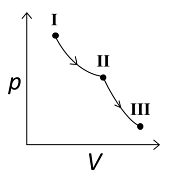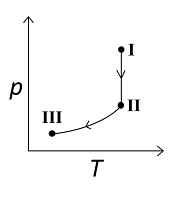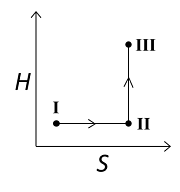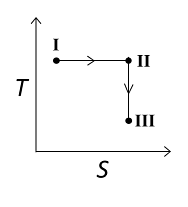An ideal gas undergoes a reversible isothermal expansion from the state I to state II followed by a reversible adiabatic expansion from state II to state III. The correct plot(s) representing the changes from the state I to state III is(are)
(p: pressure, V: volume, T: temperature, H: enthalpy, S: entropy)
(p: pressure, V: volume, T: temperature, H: enthalpy, S: entropy)
The Correct Option is A, B, D
Solution and Explanation
For the reversible isothermal expansion from state I to II:
- Pressure decreases
- Volume increases
- Temperature remains constant
- Enthalpy (H) remains constant
- Entropy (S) increases
So, all options are correct for this expansion.
For the reversible adiabatic expansion from state II to III:
- Pressure decreases
- Volume increases
- Temperature decreases
- Enthalpy (H) decreases
- Entropy (S) remains constant
Option (C) does not follow the condition of decreasing enthalpy, so it is incorrect. Options (A), (B), and (D) all follow the conditions, so they are correct.
Therefore, correct graphical representations for the given conditions are (A), (B), and (D).
Top Questions on Enthalpy change
- Arrange the following elements in increasing order of first ionization enthalpy:
Li, Be, B, C, N
Choose the correct answer from the options given below:- NEET (UG) - 2024
- Chemistry
- Enthalpy change
- Decreasing order of electron gain enthalpy of the following elements (magnitude only)
Sulphur A, Bromine - B, Fluorine C, Argon D- JEE Main - 2024
- Chemistry
- Enthalpy change
- Find the work done in the following cyclic process (in J)
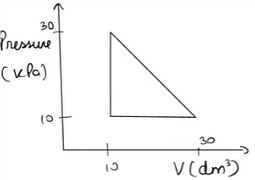
- JEE Main - 2024
- Chemistry
- Enthalpy change
If standard enthalpy of vaporization of \(CCl_4\) is \(30.5\) kJ/mol, find heat absorbed for vaporization of \(294 \) gm of \(CCl_4\). [Nearest integer] [in kJ/mol]
- JEE Main - 2024
- Chemistry
- Enthalpy change
- At $25^{\circ} C$, the enthalpy of the following processes are given: $H _2( g )+ O _2( g ) \rightarrow 2 OH ( g ) \Delta H ^{\circ} =78 \,kJ \,mol ^{-1} $ $H _2( g )+1 / 2 O _2( g ) \rightarrow H _2 O ( g ) \Delta H ^{\circ} =-242 \,kJ \,mol ^{-1} $ $H _2( g ) \rightarrow 2 H ( g ) \Delta H ^{\circ} =436\, kJ \,mol ^{-1} $ $1 / 2 O _2( g ) \rightarrow O ( g ) \Delta H ^{\circ} =249\, kJ\, mol ^{-1}$ What would be the value of $X$ for the following reaction?______ (Nearest integer) $H _2 O ( g ) \rightarrow H ( g )+ OH ( g ) \Delta H ^{\circ}= X\, kJ\, mol -1$
- JEE Main - 2023
- Chemistry
- Enthalpy change
Questions Asked in JEE Advanced exam
- Let \(S=\left\{\begin{pmatrix} 0 & 1 & c \\ 1 & a & d\\ 1 & b & e \end{pmatrix}:a,b,c,d,e\in\left\{0,1\right\}\ \text{and} |A|\in \left\{-1,1\right\}\right\}\), where |A| denotes the determinant of A. Then the number of elements in S is _______.
- JEE Advanced - 2024
- Matrices
- A block of mass \(5 kg\) moves along the \(x-\)direction subject to the force \(F = (−20x + 10) N,\) with the value of \(x \) in metre. At time \(t = 0 s,\) it is at rest at position \(x = 1 m\). The position and momentum of the block at \(t = (\pi/4)\) s are
- JEE Advanced - 2024
- Work-energy theorem
- Two equilateral-triangular prisms \(P_1 \)and \(P_2\) are kept with their sides parallel to each other, in vacuum, as shown in the figure. A light ray enters prism \(P_1\) at an angle of incidence 𝜃 such that the outgoing ray undergoes minimum deviation in prism \(P_2\). If the respective refractive indices of \(P_1\) and\( P_2\) are \(√ 3 /2\) and \(√3\), then \(\theta = sin{−1}[\sqrt \frac{ 3}{ 2} sin ( \frac{\pi}{B} )],\) where the value of \(\beta\) is ______.
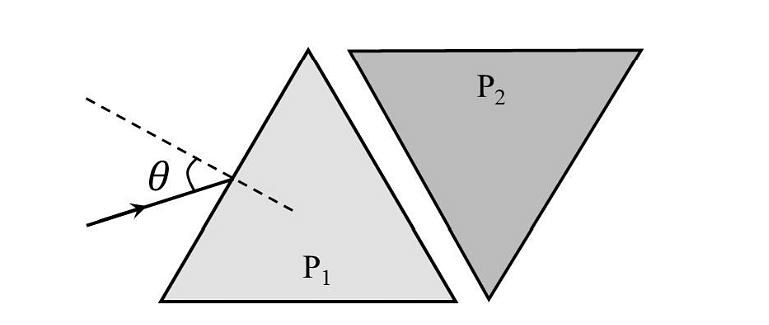
- JEE Advanced - 2024
- Ray optics and optical instruments
- Let \(\overrightarrow{OP}=\frac{\alpha-1}{\alpha}\hat{i}+\hat{j}+\hat{k},\overrightarrow{OQ}=\hat{i}+\frac{\beta-1}{\beta}\hat{j}+\hat{k}\) and \(\overrightarrow{OR}=\hat{i}+\hat{j}+\frac{1}{2}\hat{k}\) be three vector where α, β ∈ R - {0} and 0 denotes the origin. If \((\overrightarrow{OP}\times\overrightarrow{OQ}).\overrightarrow{OR}=0\) and the point (α, β, 2) lies on the plane 3x + 3y - z + l = 0, then the value of l is _______.
- JEE Advanced - 2024
- Vector Algebra
- Let \(\vec{p}=2\hat{i}+\hat{j}+3\hat{k}\) and \(\vec{q}=\hat{i}-\hat{j}+\hat{k}\). If for some real numbers α, β and γ we have
\(15\hat{i}+10\hat{j}+6\hat{k}=α(2\vec{p}+\vec{q})+β(\vec{p}-2\vec{q})+γ(\vec{p}\times\vec{q})\),
then the value of γ is ________.- JEE Advanced - 2024
- Vector Algebra
Concepts Used:
Enthalpy change
Enthalpy Change refers to the difference between the heat content of the initial and final state of the reaction. Change in enthalpy can prove to be of great importance to find whether the reaction is exothermic or endothermic.
Formula for change in enthalpy is:-
dH = dU + d(PV)
The above equation can be written in the terms of initial and final states of the system which is defined below:
UF – UI = qP –p(VF – VI)
Or qP = (UF + pVF) – (UI + pVI)
Enthalpy (H) can be written as H= U + PV. Putting the value in the above equation, we obtained:
qP = HF – HI = ∆H
Hence, change in enthalpy ∆H = qP, referred to as the heat consumed at a constant pressure by the system. At constant pressure, we can also write,
∆H = ∆U + p∆V
Standard Enthalpy of Reaction
To specify the standard enthalpy of any reaction, it is calculated when all the components participating in the reaction i.e., the reactants and the products are in their standard form. Therefore the standard enthalpy of reaction is the enthalpy change that occurs in a system when a matter is transformed by a chemical reaction under standard conditions.

